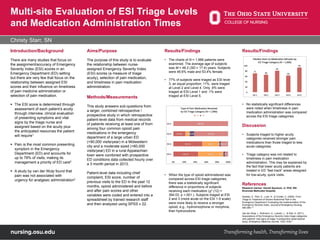Melden
Teilen
Downloaden Sie, um offline zu lesen

Empfohlen
Author: Meeta PrasadThe Effect of Resident Work Hour Regulations on ICU 5.12.08

The Effect of Resident Work Hour Regulations on ICU 5.12.08Leonard Davis Institute of Health Economics
Weitere ähnliche Inhalte
Was ist angesagt?
Author: Meeta PrasadThe Effect of Resident Work Hour Regulations on ICU 5.12.08

The Effect of Resident Work Hour Regulations on ICU 5.12.08Leonard Davis Institute of Health Economics
Was ist angesagt? (20)
The Effect of Resident Work Hour Regulations on ICU 5.12.08

The Effect of Resident Work Hour Regulations on ICU 5.12.08
Homeopathic treatment of elderly patients - a prospective observational study...

Homeopathic treatment of elderly patients - a prospective observational study...
Ähnlich wie Christy Starr Denman Poster
Ähnlich wie Christy Starr Denman Poster (20)
An Internet questionnaire to identify Drug seeking behavior in a patient in t...

An Internet questionnaire to identify Drug seeking behavior in a patient in t...
Pain Validity Test to detect drug seeking behavior

Pain Validity Test to detect drug seeking behavior
Pain Validity Test identifies drug seeking behavior. Stop opioid abuse. Prote...

Pain Validity Test identifies drug seeking behavior. Stop opioid abuse. Prote...
Exercises for Chapter 21RESEARCH ARTICLESource Rakel, B., &.docx

Exercises for Chapter 21RESEARCH ARTICLESource Rakel, B., &.docx
Evidence-Based Practice Beliefs and Behaviors of Nurses Prov.docx

Evidence-Based Practice Beliefs and Behaviors of Nurses Prov.docx
(Critical Appraisal Tools Worksheet Template)Evalua.docx

(Critical Appraisal Tools Worksheet Template)Evalua.docx
surgical nurses in teaching hospitals in Ireland understanding pain

surgical nurses in teaching hospitals in Ireland understanding pain
Running head CRITIQUE QUANTITATIVE, QUALITATIVE, OR MIXED METHODS.docx

Running head CRITIQUE QUANTITATIVE, QUALITATIVE, OR MIXED METHODS.docx
Evaluation of the Inpatient Hospital Experience while on Precautions

Evaluation of the Inpatient Hospital Experience while on Precautions
Journal Review: Rates of Treatment-Resistant Schizophrenia from First-Episode...

Journal Review: Rates of Treatment-Resistant Schizophrenia from First-Episode...
Christy Starr Denman Poster
- 1. Multi-site Evaluation of ESI Triage Levels and Medication Administration Times Christy Starr, SN Introduction/Background There are many studies that focus on the assignment/accuracy of Emergency Severity Index (ESI) scores in an Emergency Department (ED) setting but there are very few that focus on the relationship between assigned ESI scores and their influence on timeliness of pain medicine administration or selection of pain medication. § The ESI score is determined through assessment of each patient’s acuity through interview, clinical evaluation of presenting symptoms and vital signs by the triage nurse and assigned based on the acuity plus the anticipated resources the patient will require1 § Pain is the most common presenting symptom in the Emergency Department (ED) and accounts for up to 78% of visits, making its management a priority of ED care2 § A study by van der Wulp found that pain was not associated with urgency for analgesic administration3 Results/Findings • No statistically significant differences were noted when timeliness in pain medication administration was compared across the ESI triage categories. Discussion • Subjects triaged to higher acuity categories received stronger pain medications than those triaged to less acute categories. • Triage category was not related to timeliness in pain medication administration. This may be explained by the fact that lower acuity patients are treated in ED “fast track” areas designed for low-acuity, quick visits. References Research mentor: Darrell Spurlock, Jr. PhD, RN- Riverside Methodist Hospital. Swailes, E., Rich, E., Lock, K., & Cicotte, C. (2009). From Triage to Treatment of Severe Abdominal Pain in the Emergency Department: Evaluating the Implementation of the Emergency Severity Index. Journal of Emergency Nursing, 485-489.1,2 Van der Wulp, I., Rullmann, H., Leenen, L., & Stel, H. (2011). Associations of the Emergency Severity Index triage categories with patients' vital signs at triage: A prospective observational study. Emergency Medicine Journal, 1032-1035.3 Aims/Purpose The purpose of this study is to evaluate the relationship between nurse- assigned Emergency Severity Index (ESI) scores (a measure of triage acuity), selection of pain medication, and timeliness in pain medication administration. Methods/Measurements This study answers sub-questions from a larger, combined retrospective / prospective study in which retrospective patient-level data from medical records of patients receiving at least one of from among four common opioid pain medications in the emergency department of a large urban ED (>90,000 visits/year) in a Midwestern city and a moderate sized (>60,000 visits/year) ED in a rural Appalachian town were combined with prospective ED conditions data collected hourly over a 3 month period in 2013. Patient-level data including chief complaint, ESI score, number of previous visits to the ED in the past 12 months, opioid administered and before and after pain scores and other variables were coded and entered into a spreadsheet by trained research staff and then analyzed using SPSS v 22. Results/Findings • The charts of N = 1,966 patients were examined. The average age of subjects was M = 46.2 (SD = 17.4) years. Subjects were 46.6% male and 53.4% female. • 77% of subjects were triaged as ESI level 3; an equal proportion, 11%, were triaged at Level 2 and Level 4. Only .6% were triaged at ESI Level 1 and .1% were triaged at ESI Level 5. • When the type of opioid administered was compared across ESI triage categories, there was a statistically significant difference in proportions of subjects receiving each medication (χ2 (12) = 394.03, p <.001.). Subjects triaged at ESI 2 and 3 (more acute on the ESI 1-5 scale) were more likely to receive a stronger opioid, e.g., hydromorphone or morphine, than hydrocodone. 45.5% 53.1% 22.2% 45.9% 30.7% 7.4% 3.2% 3.2% 8.8% 5.5% 13.0% 61.6% 100.0% ESI 2 ESI 3 ESI 4 ESI 5 0% 20% 40% 60% 80% 100% Type of Pain Medica;on Received by ESI Triage Category (N = 1,966) 71 66 81 63 93 0 20 40 60 80 100 ESI 1 ESI 2 ESI 3 ESI 4 ESI 5 Median Door-‐to-‐Medica;on Minutes by ESI Triage Category (N = 1,966)